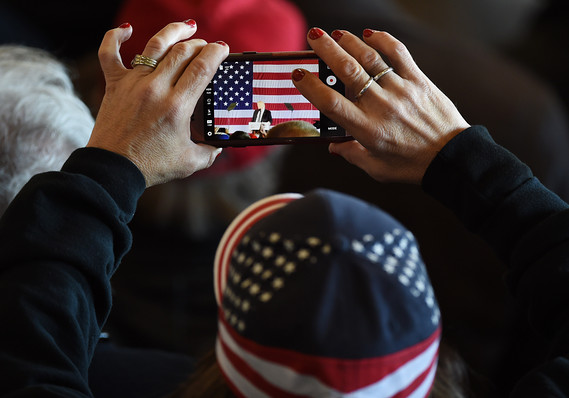 DON EMMERT/AFP/Getty Images
DON EMMERT/AFP/Getty Images Anyone who keeps one eye on the stock market and the other on President Donald Trump’s TWTR, -2.28% feed can tell you that the two have become highly correlated. And in this case, correlation implies causation.
All it takes is a Trump tweet hinting at imminent trade talks with China, and the Dow Jones Industrial Average DJIA, +0.28% launches into orbit, with “trade optimism” underpinning the price action.
Trump’s tweets on trade and monetary policy are having a “statistically significant” effect on U.S. Treasury prices TMUBMUSD10Y, -1.19% as well, according to JPMorgan Chase, which just introduced its “Volfefe” Index to quantify those effects. (”Volfefe” is a melding of “volatility” and “covfefe,” a Trumped-up word from a May 2017 tweet.)
Tim Mullaney: The cost of Trump keeps rising almost daily
The idea that the president’s tweets can erase billions of dollars in value from the stock market in a matter of minutes got me thinking about the true cost, not just the financial cost to traders and investors, of social media.
A poor substitute
To the extent that our portable devices have made it possible for us to be “Alone Together,” a metaphor coined by MIT psychologist Sherry Turkle and the title of her book, social media platforms were touted as a virtual gathering place, a substitute for face-to-face interaction.
As it turned out, not only is social media a poor substitute for human interaction but it is a harmful one as well.
It took some time for neurologists and psychologists to document the negative effects all of this digital togetherness is having on our brains and our lives. It has reduced our attention spans, created a nation of addicts craving the dopamine rush from feedback from followers, contributed to an increase in mental-health problems among teens, affected the way news is consumed and delivered, and even provided a support system for sick individuals contemplating terrorist acts.
Economists have been slower than psychologists and neurologists to quantify the negative effect of social media and smart phones, but available research suggests that they are depressing worker productivity.
You don’t have to be a statistician to understand that if we fritter away an increased portion of our eight-hour workday chatting on social media, emailing with friends and texting about non-work-related matters, our output-per-hour worked has to fall. (No, smartphones aren’t making us smarter.)
An obsession
I confess that I’ve been interested for a long time— obsessed might be a better word — in the deleterious effects of social media and smartphones that enable instant access.
I first wrote about the effect in 2012 in response to a study that claimed Facebook FB, -1.37% was making people fat. Apparently the increase in self-esteem from social networking was reducing control over snack foods, according to the study.
Pretty soon any of the hypothesized boost to self-esteem was overpowered by the damaging effect that “screen time” was having on today’s youth, creating a “mental-health crisis” among adolescents, according to Jean M. Twenge, a professor of psychology at San Diego State University, writing in the September 2017 issue of The Atlantic.
“The more time teens spend looking at screens, the more likely they are to report symptoms of depression,” Twenge writes.
Trump uses Twitter to conduct diplomacy, hire and fire staff, demean opponents and influence policy; at least he tries when it comes to policy. The president regularly chastises the Federal Reserve and Chair Jerome Powell for raising rates too aggressively last year and for not giving him the big reduction in interest rates he wants now to send the economy and stock market soaring “like a rocket ship” going into the 2020 election.
While Trump’s prodding was unlikely to have influenced the Fed’s decision to lower the federal funds rate on July 31 for the first time since 2008, it creates bad optics and makes it harder for the Fed to appear to be acting independently. There was even speculation that the Fed might refrain from lowering interest rates, even if that were the right policy course, to avoid any appearance of impropriety in kowtowing to the president’s wishes.
Not quantifiable
These costs may not be quantifiable in the same way that the Volfefe Index captures tweet-driven changes in the prices of U.S. Treasury securities. But they are costs to society — and to our system of government — just the same.
Russia harnessed the power and reach of social media to try and sway voters in the 2016 presidential election. And Trump recently tweeted a satellite photo, thought to be classified, of an explosion at an Iranian space center. At some point, the cost of sharing classified information — especially as it pertains to a foreign asset — when it suits his fancy will be lost lives.
The president was an avid Twitter user before he came to the White House, and he has used social media to his advantage. Heck, who needs the daily White House briefing for the Washington press corps when you can speak directly to 64 million Twitter followers 24/7?
Social media has proven to be a poor way to communicate anything of substance, exacerbating the deterioration in social discourse. It has created discord, not cohesion, by inviting nasty back-and-forth exchanges among strangers, with all manner of bystanders chiming in.
Remember when politicians actually talked to one another, in person and in private, in an attempt to reach consensus and solve problems instead of firing off 280-character one-liners for all the world to see?





